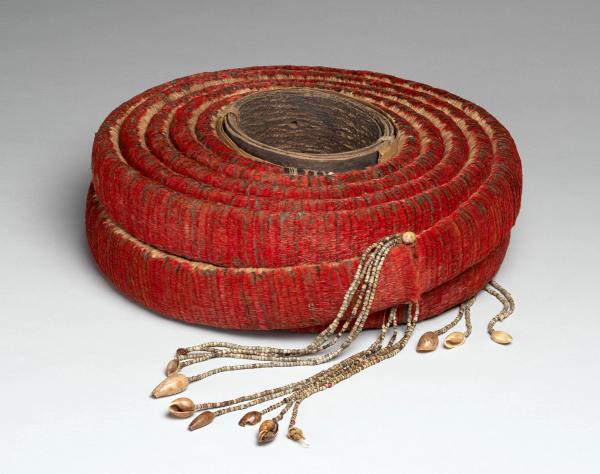Money Coil (Tevau)
The coils are made from the feathers of the scarlet honeyeater (Myzomela cardinalis), known locally as mungau. Throughout much of the Pacific, red feathers are revered as a sacred and spiritually charged material and as such they are a valuable exchange item. The production of tevau is the work of three distinct specialists. One man was responsible for trapping the birds and harvesting their feathers. Another would fix the red feathers into small plates by using tree gum to adhere them to structure of larger pigeon feathers. A third specialist would assemble the plates onto a woven base supported by a bark coil. The specialist knowledge involved in making tevau was held in certain family lines and tightly guarded. According to legend, the knowledge was first taught to humans by forest dwelling spirits, who warned that if the men shared what they had learned they would lose their good fortune.
The value of tevau is determined by its size and quality of the red feathers. A tevau of this size would likely contain the feathers of 300 or more birds and have taken hundreds of hours to make. The value of the coils would decline as the feathers weathered and faded so the most valued were those that were vital, red and fresh. A turtle shell charm placed inside this coil further adds to its value. The stings of coix seeds and small shells that are attached to the piece are a marker of time and labor involved in its manufacture, and are placed at the start, end and center point of the coil. For both spiritual and environmental protection, tevau would be stored wrapped in leaves and suspended from the rafters of houses, where the smoke from fires would ward away insects while wooden charms placed in the wrappings protected against malevolent spirits.
Tevau could be used in payment for high value items such as canoes and the pigs that are central to the village economies in many Pacific cultures. Tevau also played an important role in the payment of bride wealth – the compensation to the bride’s family for the loss of her generative potential as a mother and grower of crops. Other uses for tevau included compensation payments to settle disputes, presentations to ancestral spirits, and as payments for courtesans from the Reef Islands who were purchased to reside in the men’s house.
During the twentieth century, knowledge of how to make tevau largely diminished in the islands, as cash replaced feather money within the local economy. However, in recent years there have been attempts in Temotu Province to revive tevau, and in the year 2000 three men from Noipe village in Santa Cruz were trained in the sacred knowledge of tevau making.
Artwork Details
- Title: Money Coil (Tevau)
- Date: late 19th–early 20th century
- Geography: Solomon Islands, Santa Cruz Islands, Temotu Province
- Culture: Santa Cruz Islands
- Medium: Feathers, fiber, bark, seeds, shell, glass beads, leaves
- Dimensions: (On mount) H. 21 in. × W. 30 1/2 in. × D. 5 in. × L. 26 ft. 9 in. (53.3 × 77.5 × 12.7 × 815.3 cm)
- Classification: Textiles-Non-Woven
- Credit Line: Anonymous Gift, 2010
- Object Number: 2010.326
- Curatorial Department: The Michael C. Rockefeller Wing
Audio

1780. Tevau (feather money coils), Ndende artists
Patricia George
PATRICIA GEORGE: The more red the color is, the more valuable it is, because the red in our culture symbolizes blood. Hello, my name is Patricia George.
KATERINA TEAIWA (NARRATOR): Patricia George has worked at the Solomon Islands National Museum for more than 30 years.
PATRICIA GEORGE: Tevau is where I come from, Santa Cruz Island. So tevau is our traditional currency.
KATERINA TEAIWA: Tevau is used as part of ceremonial exchanges, like those that take place before a marriage.
PATRICIA GEORGE: When they negotiated the bride price, the groom’s relatives and the bride’s relatives will sit down together and negotiate a price. So they might say, “We want 20 red feather money currency.”
KATERINA TEAIWA: According to lore, people began making tevau after an exiled man wandering in the bush encountered a lemwurbz, or spirit god, who took him...
PATRICIA GEORGE: ...and fed him, look after him, and they taught him how to make this tevau.
KATERINA TEAIWA: In today’s Santa Cruz, red feather money remains a source of pride and retains its symbolic importance. But actual examples are scarce.
PATRICIA GEORGE: It’s very rare now to find an old one in the village.
In 2000, me and my late husband tried to revive the red feather money. We had a project. We asked those who have the knowledge if they could pass down the knowledge. They passed the knowledge to young people, and I think three or four now have the knowledge to making the red feather money.
KATERINA TEAIWA: Making tevau is a painstaking process. Look closely and you’ll see the thousands of red feathers. Individually attaching them to make a complete coil takes hundreds of hours.
PATRICIA GEORGE: 70,000 feathers. The bird catcher catch the bird, pull off the red feathers, leave the bird fly alive. They don’t kill the bird. The bird then grow more feathers.
More Artwork
Research Resources
The Met provides unparalleled resources for research and welcomes an international community of students and scholars. The Met's Open Access API is where creators and researchers can connect to the The Met collection. Open Access data and public domain images are available for unrestricted commercial and noncommercial use without permission or fee.
To request images under copyright and other restrictions, please use this Image Request form.
Feedback
We continue to research and examine historical and cultural context for objects in The Met collection. If you have comments or questions about this object record, please contact us using the form below. The Museum looks forward to receiving your comments.
